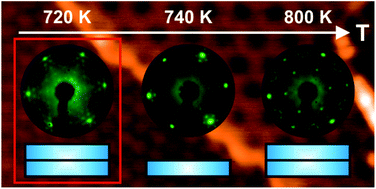Observation of a novel double layer surface oxide phase on Ni3Al(111) at low temperature†
Abstract
The Ni3Al(111) surface was characterized during oxidation within the temperature range of 690–800 K by in situ scanning tunneling microscopy (STM), low energy electron diffraction (LEED) and auger electron spectroscopy (AES). Within this temperature range oxygen dosing always leads to the formation of a surface aluminum oxide layer while Ni atoms remain in their metallic state. The temperature however, affects the kinetics and the structure of the grown oxides. Above 790 K the known (√67 × √67)R12.2° double layer oxide grows, which consists of two Al–O layers. Oxygen dosing at the lower temperature of 740 ± 10 K leads to a single layer oxide with only one Al–O plane. The lattice mismatch of the aligned oxygen and substrate lattices induce a (7 × 7) moiré pattern of this surface phase. Surprisingly, when lowering the sample temperature below 720 K during oxygen exposure, again a bilayer oxide grows on the Ni3Al(111) surface. The formation of this bilayer oxide starts with the growth of the single layer oxide that is subsequently covered by a second Al–O layer. At temperatures close to 720 K, the 2nd layer is ordered and a diffraction pattern is observed indicating a (4√3 × 4√3)R30° unit cell with regard to the oxygen lattice of the surface oxide. A structure model is presented that relates this so far unknown double layer oxide to the building principle of α-Al2O3. The respective growth kinetics and the availability of Al atoms dictate whether the single or the low temperature double layer oxide is formed. The related mass transport on the surface can be observed using in situ STM which allows the qualitative discussion of the growth kinetics. When lowering the oxide growth temperature below 700 K, the 2nd oxide layer is still formed ontop of the single layer oxide but in a disordered state so that the LEED pattern of the single layer oxide with a (7 × 7) moiré unit cell is again observed. This accounts for the confusing fact that the (7 × 7) moiré LEED pattern may indicate either the formation of a single or a low temperature double layer oxide.



 Please wait while we load your content...
Please wait while we load your content...